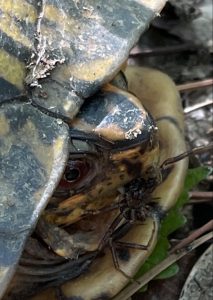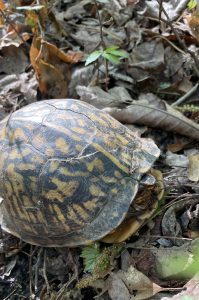Healthy Soil, Healthy Trees, and Healthy Habitat for the Amazing Eastern Box Turtle
Peter Girardi

If you have been out in the woods walking around these past few weeks, it’s very likely that you have seen an eastern box turtle. If not, get out there (or back out there) and walk around and see if you can spot one. What does this have to do with trees? Well, I may repeat myself on what a tree needs and what makes healthy soil for a tree, but the habitat for the box turtle may also be the same. You will not find a box turtle living in the grass around a majestic oak tree, but I do think you might find a box turtle under the leaves below an oak tree in the woods, or in a yard that has been landscaped to be more like a woodland habitat.

I bring up the eastern box turtle for another reason – because their population has been declining due to habitat loss. The more woodlands that we can keep intact (or keep from turning into lawns), then the better the chance the turtle and other animals will have a suitable habitat.
Let’s start with what healthy soil and healthy trees might need to improve the health of your tree
(information below taken from my article I wrote previously https://www.urbanforestdweller.com/how-to-make-your-backyard-soil-come-alive/):
- Don’t be afraid to start improving your yard or the soil in your yard. Just start small and the rest can happen organically. Maybe start with one tree or one area of the yard.
- Mulch a larger portion of your tree’s roots. The idea of this is for more diverse planting, but also to eliminate the amount of lawn/turf over the tree’s root system.
- Eliminate fertilizers, herbicides, or pesticides around your yard and trees, if possible, to help protect the living microbes in the soil that are working with your trees.
- Keep your leaves around your trees and yard; mimic the forest. Let nature landscape your yard.
- Plant your yard like a healthy forest with different species of trees and plants, different sizes of trees and plants, and ground cover plants that you would find in the woods.

What does a box turtle need for habitat
(info below in quotes is taken from this article https://www.virginiaherpetologicalsociety.com/reptiles/turtles/eastern-box-turtle/eastern_box_turtle.php):
- “Box Turtle is found in many types of wooded areas, including hardwood forests, mixed oak-pine forests, pine flat woods, maritime oak forests, hardwood swamps, and agricultural areas”
- “They overwinter buried several centimeters in the soil beneath leaf piles and grass clumps”
What is Peter going to do about this in his yard?
- First off, I still have a lot of grass in my backyard that I need to convert to more leaves and understory plantings. I hope that some of the plantings will come naturally when I stop mowing the grass in those areas. Also, turtles cannot dig in the turf soil (it’s just too hard).
- I may jump-start converting the grass to mulch by adding some fresh tree mulch that includes leaves, sticks, and all parts of a tree. A website to sign-up for chips is chipdrop.com; this is a good place to get free mulch.
- I may start planting native understory trees and plants from other parts of my own yard to help start the process.
- I will remove invasive plants like English ivy, honeysuckle vine, and privet from my yard

So basically, by following the steps above, we’re helping out our eastern box turtle friends. Plus in turn, we all get the following benefits: natural canopy coverage, free mulch, free droppings for said mulch, potentially free berry plants (from said droppings), some free insect control (which the eastern box turtle eats), and more.


